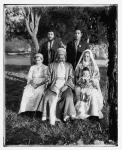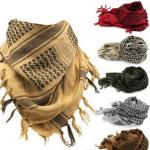Judaica: Scarf Desert Sudra KeffIyeh, various colours DISCONTINUED
Colours available are:
red
yellow
green
wjite
purple
with black
Material: 100% Cotton
Size: 95 x 95 CM
Weight: About 65G
I include the keffiyeh in this Judaica collection as a symbol of the hope for unity amongst all Semitic peoples.
WHAT IS THE SUDRA (in Hebraic: סודרא)?
The Sudra is 'the keffiyeh of the Jews'. The name Sudra is Aramaic and derived from the Latin word "sudarium", which means cloth or handkerchief. The sudra is believed to be thousands of years old and has been mentioned directly and indirectly in many of the ancient religious texts of Judaism including the Babylonian Talmud, The First and Second Books of the Maccabees, and in the Book of Ruth. Ancient Hebrews wore headgear with many ways of tying the fabric to make different designs including as a twisted scarf worn around the neck, on their heads like a keffiyeh or as a turbin such as in the Babylonian Talmud.
WHY DID JEWS STOP WEARING THE SUDRA?
There are numerous reasons why sudras have fallen out of favour with modern Jews. According to Benny Katz of the Zionist Freedom Alliance (ZFA):
"In ancient times, it was common for Jews to wear keffiyot, but the conquest of the region by Islamic tribes brought with it a series of laws that gave non-Muslims an inferior position in society. Synagogues could not be built higher than mosques and Jews could not ride atop animals for fear that they would appear higher than Muslims. As the keffiyeh came to be seen as the crown of the Arabs and its wearer was attributed an honourable status, non-Muslims were forbidden from wearing such garments.”
WHAT IS THE KEFFIYEH?
The keffiyeh or kufiya (Arabic: كُوفِيَّة kūfiyyah, meaning "from the city of Kufa" (الْكُوفَة); plural كُوفِيَّات kūfiyyāt), also known as a ghutrah (غُترَة), shemagh (شُمَاغ šumāġ), ḥaṭṭah (حَطَّة), mashadah (مَشَدَة), chafiye, dastmal yazdi (Kurdish: دستمال یزدی) or cemedanî (Kurdish: جه مه داني), is a traditional Middle Eastern, headdress worn in the Middle East, with origins from the Fertile Crescent (Iraq and the Levant) fashioned from a square scarf, usually made of cotton. sometimes mixed with wool. It is commonly found in arid regions as it provides protection from sunburn, dust and sand.
A BRIEF HISTORY OF WEARING THE KEFFIYEH
A practical accessory for the desert, issues by dozens of armies, police forces and institutions, the keffiyeh has been infused with political and social meaning since the early twentieth century.
1930s Traditionally worn by Palestinian farmers, the keffiyeh became worn by Palestinian men of any rank as a symbol of Palestinian nationalism.
1960s Its prominence increased with the beginning of the Palestinian resistance movement and its adoption by Palestinian leader Yasser Arafat.
1970s Leila Khaled popularized wearing a keffiyeh in the style of a Muslim woman's hijab, wrapped around the head and shoulders. Many believe this to be something of a fashion statement by Khaled, denoting her equality with men in the Palestinian struggle.
1980s The keffiyeh became a fashion accessory in the United States.
2000s The trend recurred in the mid-2000s in the United States. Europe, Canada and Australia, when the keffiyeh became popular as a fashion accessory, usually worn as a scarf around the neck in hipster circles. The keffiyeh became very popular among teenagers in Tokyo, Japan, where it is often worn with camouflage-style clothing.
The slang "keffiyeh kinderlach" refers to young Jews, particularly college students, who sport a keffiyeh around the neck as a political/fashion statement. European activists also wear the keffiyeh.
COLOURS AND PATTERNS
While Western protesters wear differing styles and shades of keffiyeh, the most prominent is the black-and-white keffiyeh associated with Palestine. The colour symbolism of the scarves is by no means universal, as the scarves are used by Palestinians and Arabs of all political affiliations, as well as by those with no particular political sympathies.
Photo of Yemeni Jew in a sudra thanks to American Colony (Jerusalem). Photo Dept., photographer. [Public domain]







